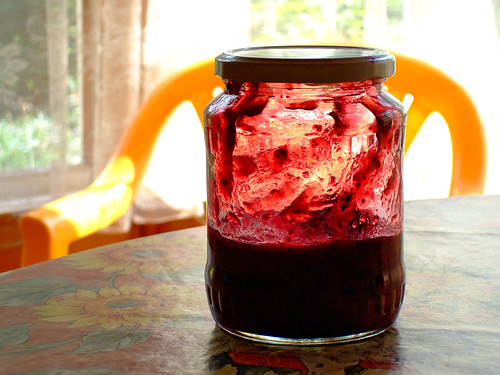
 Photo by oksidorIt’s officially summer, and if you’ve been thinking traffic jam, start thinking of a tastier, less stressful kind of jam – the kind that uses wild blueberries, raspberries, apricots, even cherries to spreadable, delicious effect.
Photo by oksidorIt’s officially summer, and if you’ve been thinking traffic jam, start thinking of a tastier, less stressful kind of jam – the kind that uses wild blueberries, raspberries, apricots, even cherries to spreadable, delicious effect.
After all, jam is really spreadable fruit, and potentially, one of the tastier ways to get a serving. But while the delicious fruits of summer are this food’s main ingredient, jam does present some hidden health dilemmas. It’s a valid question: is eating jam as a fruit serving cheating?
Getting the Best of Jam
Before we fully embrace jams, spreads, jellies and other preserves as a fruit serving boon to meet the fruit-and-vegetable-heavy requirements of our new MyPlate nutritional guidelines, keep in mind that sugar is the edible albatross of jam.
Jams are, generally speaking, loaded down with sugar, especially if they are from the grocery store shelf. Jams can be highly processed and include excess high fructose corn syrup, and they can be high in calories as well. Also, cooking fruit in the process of making jams and preserves can accelerate the loss of vitamins, eroding what was originally a nutritional powerhouse.
How can all this fruit, the cornerstone of healthy eating and disease prevention, take such an evil turn when it turns to mush? It doesn’t have to. While there are good reasons to remain cautious when it comes to jam intake, there are also many advantages to embracing pulverized produce as a topping for your scone, toast, yogurt or in a classic PB&J.
Jams come with concerns, like any other food, but if your goal is to eat widely and colorfully, it belongs on your plate, and it can enhance your healthy eating goals – particularly if you are up for a little preparation in your own kitchen.
Jam’s advantages:
- It boosts energy. The sugars are perfect for snacking or adding to breakfast items for a quick oomph.
- It has half the calories of butter as a topper, and is low in cholesterol.
- It still has all the benefits of fruit, most notably, heart healthy, cancer fighting antioxidant power. It aids is maintaining healthy blood pressure, and when you make it yourself, it’s a concentrated wallop of nutrition.
- It tastes amazing. Sweet and savory, and full of whole fruit pieces, jams and jellies are like candy without the empty calories.
- It’s and ideal way to preserve the tastes of the season when the berries start flowing, for days later or months later.
- If you are picking the fruit yourself to turn into jam, you can capture it when it’s fully ripe for the best nutritional value.
Enjoy Jam, Maintain Your Health
Low sugar fruit preserves are available on the store shelf, but an alternative to enjoying all the wonders of fruit in jam form without the high sugar content and preservatives is to make it yourself.
You can learn how to can (many communities offer canning classes this time of year) or go the simple route and mash fresh-picked fruit, add a little cinnamon, lemon and a dash of sugar, and spread. If you’ve got a hankering for real blueberry jam and you’re sitting on a few pints of blueberries from a local farm, for instance, here’s a simple way to create it that is ideal for the canning-phobic. We’ve used the principles of blueberry jam making from Real Simple:
Easy Wild Blueberry Jam
For 3 cups of blueberry jam, use 5 cups of wild blueberries, ½ cup of sugar, 1 tablespoon of fresh lemon juice and ¼ teaspoon of kosher salt.
Combine and mash with a potato masher, cook over medium-high heat for 18-25 minutes and refrigerate.
You can also use frozen (any time of year): substitute two 10 ounce bags, and cook them for 2-3 minutes before mashing, then reduce the cooking time by the same.
Glazes: It’s All About the Grill
When is a fruit not fruit? When it’s a jam, jelly, sauce or glaze, of course, perfectly prepared to enliven barbecue and provide the zing to meats and other summer grilling items. Shannon Bissonnette has a handle on the full glazing picture. She is the owner and operator of Better Than Average Jams, Jellies and Sauces located in Mechanic Falls, Maine, and her specialty is fruit completely transformed, made from local ingredients that showcase unique flavors for spreading on breads or on BBQ.
Embrace the flavor of evolved fruit: add Raspberry Jalapeno Jam, Zesty Apple BBQ Glaze, or Blueberry Chipotle Stout BBQ Sauce to your outdoor grilling repertoire! You can read more about Shannon here (scroll down for the recipes).
Summer Jam: Spread the Love
Learn about preserving, and find organic blueberry jam recipes at Peace & Plenty Farm.
Remember that tomatoes benefit nutritionally from cooking! Try this Spicy Tomato Jam recipe.
Make a classic Strawberry Jam, or get the skinny on other classic combos such as Blueberry Rhubarb Jam on the ifood TV network.
The University of Maine Cooperative Extension has tips on making wild blueberry jam for preserving, among other ways to use and preserve Maine foods, such as fiddleheads.